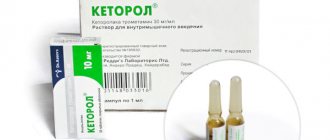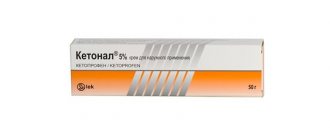Ibuklin Junior
INSTRUCTIONS for the use of the medicinal product for medical use IBUCLIN JUNIOR ®
Registration number: P N011252/02
Trade name of the drug: Ibuklin Junior®
INN or generic name of the drug: Ibuprofen + Paracetamol
Dosage form: dispersible tablets [for children]
Composition Each dispersible tablet [for children] contains: active ingredients: ibuprofen 100 mg, paracetamol 125 mg; excipients: microcrystalline cellulose 20 mg, corn starch 59.04 mg, lactose 5 mg, sodium carboxymethyl starch (type A) 30 mg, crimson dye (Ponceau 4R) (E124) 0.2 mg, glycerol 2 mg, colloidal silicon dioxide 5 mg, orange flavor DC 100 PH 1.6 mg, pineapple flavor DC 106 PH 2.5 mg, peppermint leaf oil 0.66 mg, aspartame 10 mg, magnesium stearate 1 mg, talc 3 mg.
Description Tablets are flat-cylindrical in shape, pink in color with inclusions, with a bevel and a score on one side and a fruity-mint odor.
Pharmacotherapeutic group: analgesic, combined (NSAID + analgesic non-narcotic drug).
ATX code: M01AE51
Pharmacological properties Pharmacodynamics A combined drug, the effect of which is determined by the components included in its composition. Ibuprofen is a nonsteroidal anti-inflammatory drug (NSAID) that has analgesic, anti-inflammatory, and antipyretic effects. By inhibiting cyclooxygenase (COX) 1 and 2, it disrupts the metabolism of arachidonic acid, reduces the amount of prostaglandins (mediators of pain, inflammation and hyperthermic reaction) both in the site of inflammation and in healthy tissues, suppresses the exudative and proliferative phases of inflammation. Paracetamol indiscriminately blocks COX, mainly in the central nervous system, and has little effect on water-salt metabolism and the mucous membrane of the gastrointestinal tract (GIT). Has an analgesic and antipyretic effect. In inflamed tissues, peroxidases neutralize the effect of paracetamol on COX 1 and 2, which explains the low anti-inflammatory effect. The effectiveness of the combination is higher than that of individual components. Pharmacokinetics of Ibuprofen. Absorption is high, quickly and almost completely absorbed from the gastrointestinal tract (GIT). The time to reach maximum concentration (TCmax) after oral administration is about 1-2 hours. Communication with blood plasma proteins is more than 90%. The half-life (T1/2) is about 2 hours. It slowly penetrates into the joint cavity, accumulates in the synovial fluid, creating higher concentrations in it than in the blood plasma. After absorption, about 60% of the pharmacologically inactive R-form is slowly transformed into the active S-form. Metabolized. More than 90% is excreted by the kidneys (no more than 1% unchanged) and, to a lesser extent, with bile in the form of metabolites and their conjugates. Paracetamol. Absorption is high, binding to plasma proteins is less than 10% and increases slightly with overdose. Sulfate and glucuronide metabolites do not bind to plasma proteins even at relatively high concentrations. The Cmax value is 5-20 mcg/ml, TCmax is 0.5 - 2 hours. Distributed fairly evenly in body fluids. Penetrates the blood-brain barrier. About 90 - 95% of paracetamol is metabolized in the liver to form inactive conjugates with glucuronic acid (60%), taurine (35%) and cysteine (3%), as well as a small amount of hydroxylated and deacetylated metabolites. A small part of the drug is hydroxylated by microsomal enzymes to form highly active N - acetyl - n - benzoquinone imine, which binds to the sulfhydryl groups of glutathione. When glutathione reserves in the liver are depleted (in case of overdose), the enzyme systems of hepatocytes can be blocked, leading to the development of their necrosis. T1/2 – 2-3 hours. Excreted by the kidneys, mainly in the form of glucuronide and sulfate conjugates (less than 5% unchanged). Less than 1% of the administered dose of paracetamol passes into breast milk. In children, the ability to form conjugates with glucuronic acid is lower than in adults.
Indications for use: Feverish syndrome. Pain syndrome of weak or moderate intensity of various etiologies: toothache, pain during sprains, dislocations, fractures. As an auxiliary drug for the treatment of pain and fever in sinusitis, tonsillitis, acute infectious and inflammatory diseases of the upper respiratory tract (pharyngitis, tracheitis, laryngitis).
Contraindications Increased individual sensitivity to the components of the drug (including other NSAIDs), peptic ulcer of the stomach and duodenum in the acute phase, complete or incomplete combination of bronchial asthma, recurrent polyposis of the nose and paranasal sinuses and intolerance to acetylsalicylic acid or other NSAIDs (including history), severe renal failure (creatinine clearance less than 30 ml/min), optic nerve damage, genetic absence of glucose - 6 - phosphate dehydrogenase, diseases of the blood system, the period after coronary artery bypass surgery, progressive kidney disease, severe liver failure or active liver disease, confirmed hyperkalemia, active gastrointestinal bleeding, inflammatory bowel diseases, children (up to 3 years).
Method of administration and dosage regimen The drug is taken orally. Before use, the Ibuklin Junior® tablet should be dissolved in 5 ml (1 teaspoon) of water. The daily dose of the drug is taken in 2-3 doses. The minimum time interval between taking the drug is 4 hours. Children over 3 years old. Single dose – 1 tablet. The daily dose depends on the age and weight of the child: 3-6 years (13-20 kg) - 3 tablets per day; 6-12 years (20-40 kg) - up to 6 tablets per day. In case of impaired renal or liver function, the interval between doses of the drug should be at least 8 hours. The drug should not be taken for more than 5 days as an analgesic and for more than 3 days as an antipyretic without medical supervision.
Precautions for use : Chronic heart failure, cerebrovascular disease, dyslipidemia/hyperlipidemia, diabetes mellitus, peripheral arterial disease, smoking, creatinine clearance less than 60 ml/min, history of ulcerative lesions of the gastrointestinal tract, presence of Helicobacter pylori infection, long-term use of NSAIDs, alcoholism , severe somatic diseases, simultaneous use of oral glucocorticosteroids (including prednisolone), anticoagulants (including warfarin), antiplatelet agents (including acetylsalicylic acid, clopidogrel), selective serotonin reuptake inhibitors (including citalopram, fluoxetine, paroxetine, sertraline).
Use during pregnancy and lactation If it is necessary to use the drug Ibuklin Junior® during pregnancy and lactation (breastfeeding), you should carefully weigh the expected benefits of therapy for the mother and the potential risk for the fetus or child. If it is necessary to use it in the first trimester of pregnancy, long-term use of the drug Ibuklin Junior should be avoided. If short-term use of the drug Ibuklin Junior® is necessary during lactation, cessation of breastfeeding is usually not required. Experimental studies have not established the embryotoxic, teratogenic and mutagenic effects of the components of the drug Ibuklin Junior®.
Symptoms of overdose, measures to assist in case of overdose Symptoms: gastrointestinal disorders (abdominal pain, diarrhea, nausea, vomiting, anorexia, epigastric pain), increased prothrombin time, bleeding after 12 - 48 hours, lethargy, drowsiness, depression, headache, tinnitus, impaired consciousness, heart rhythm disturbances, decreased blood pressure, manifestations of hepato- and nephrotoxicity, convulsions, possible development of hepatonecrosis. Treatment: gastric lavage during the first 4 hours; alkaline drinking, forced diuresis; activated carbon orally, administration of SH-group donors and precursors for the synthesis of glutathione - methionine 8-9 hours after an overdose and N-acetylcysteine orally or intravenously - after 12 hours, antacid drugs; hemodialysis; symptomatic therapy. The need for additional therapeutic measures (further administration of methionine, intravenous administration of N-acetylcysteine) is determined depending on the concentration of paracetamol in the blood, as well as the time elapsed after its administration.
Possible side effects when using the drug In therapeutic doses, the drug is usually well tolerated. From the digestive system: rarely - dyspeptic symptoms, with long-term use in high doses - hepatotoxic effect. From the hematopoietic system: rarely - thrombocytopenia, leukopenia, pancytopenia, neutropenia, agranulocytosis. Allergic reactions: rarely - skin rash, itching, urticaria. If side effects occur, you should stop taking the drug and consult a doctor.
Interaction with other drugs and (or) food products When using the drug Ibuklin Junior® simultaneously with drugs, various interaction effects may develop. Long-term combined use with paracetamol increases the risk of nephrotoxic effects. Combination with ethanol, glucocorticosteroids, corticotropin increases the risk of erosive and ulcerative lesions of the gastrointestinal tract. Ibuprofen enhances the effect of direct (heparin) and indirect (coumarin and indanedione derivatives) anticoagulants, thrombolytic agents (alteplase, anistreplase, streptokinase, urokinase), antiplatelet agents, colchicine - the risk of developing hemorrhagic complications increases. Enhances the hypoglycemic effect of insulin and oral hypoglycemic drugs. Weakens the effects of antihypertensive drugs and diuretics (by inhibiting the synthesis of renal prostaglandins). Increases the blood concentration of digoxin, lithium and methotrexate. Caffeine enhances the analgesic effect of ibuprofen. Cyclosporine and gold preparations increase nephrotoxicity. Cefamandole, cefoperazone, cefotetan, valproic acid, plicamycin increase the incidence of hypoprothrombinemia. Antacids and cholestyramine reduce the absorption of the drug. Myelotoxic drugs contribute to the manifestation of hematotoxicity of the drug.
Special instructions The advisability of using the drug as an antipyretic is decided in each case, depending on the severity, nature and tolerability of the febrile syndrome. Ibuprofen may mask objective signs of infectious diseases, so ibuprofen therapy in patients with infectious diseases should be prescribed with caution. To reduce the risk of developing adverse events from the gastrointestinal tract, the minimum effective dose should be used for the shortest possible short course. With the simultaneous use of indirect anticoagulants, it is necessary to monitor the indicators of the blood coagulation system. Co-administration of Ibuklin Junior with other NSAIDs should be avoided. With long-term (more than 5 days) use of the drug, monitoring of peripheral blood and the functional state of the liver is necessary. The drug may distort the results of laboratory tests when quantitatively determining glucose, uric acid in blood serum, and 17-ketosteroids (the drug must be discontinued 48 hours before the test).
Impact on the ability to drive vehicles and machinery During the treatment period, the patient should refrain from engaging in potentially hazardous activities that require increased attention and speed of psychomotor reactions.
Release form Dispersible tablets [for children] 100 mg + 125 mg. 10 tablets per PVC/Al blister. 1, 2 or 20 blisters along with instructions for use in a cardboard pack.
Storage conditions : Protected from light at a temperature not exceeding 25 °C. Keep out of the reach of children!
Shelf life: 5 years. Do not use after the expiration date stated on the packaging.
Conditions for dispensing from pharmacies By prescription.
Manufacturer Dr. Reddy's Laboratories Ltd., India Dr. Reddy's Laboratories Ltd., India
Address of production place 1. Unit-1, Plot No. 137, 138 & 146, SV Co-op. Industrial Estate, Bollaram, Jinnaram Mandal, Medak District, Telangana State, India 2. Khol, Nalagarh Road, Baddi, Dist. Solan, Himachal Pradesh, India.
Information about complaints and adverse drug reactions should be sent to the following address: Representative office: 115035, Moscow, Ovchinnikovskaya embankment, 20, building 1 tel. fax
Ibuklin® (Ibuclin)
With the simultaneous use of Ibuklin® with drugs, various interaction effects may develop.
When taken simultaneously with acetylsalicylic acid, ibuprofen reduces its anti-inflammatory and antiaggregation effect (an increase in the incidence of acute coronary insufficiency in patients receiving small doses of acetylsalicylic acid as an antiaggregation agent is possible after the start of administration).
Combination with ethanol, glucocorticosteroids, corticotropin increases the risk of erosive and ulcerative lesions of the gastrointestinal tract.
Ibuprofen enhances the effect of direct (heparin) and indirect (coumarin and indanedione derivatives) anticoagulants, thrombolytic agents (alteplase, anistreplase, streptokinase, urokinase), antiplatelet agents, colchicine - the risk of developing hemorrhagic complications increases.
Enhances the hypoglycemic effect of insulin and oral hypoglycemic drugs.
Weakens the effects of antihypertensive drugs and diuretics (by inhibiting the synthesis of renal prostaglandins).
Increases the blood concentration of digoxin, lithium and methotrexate.
Caffeine enhances the analgesic effect of ibuprofen.
Cyclosporine and gold preparations increase nephrotoxicity.
Cefamandole, cefoperazone, cefotetan, valproic acid, plicamycin increase the incidence of hypoprothrombinemia.
Quinolone antibiotics: In patients receiving concomitant treatment with NSAIDs and quinolone antibiotics, the risk of seizures may be increased. Antacids and cholestyramine reduce the absorption of the drug.
Myelotoxic drugs contribute to the manifestation of hematotoxicity of the drug.
Mifepristone: NSAIDs should be started no earlier than 8-12 days after taking mifepristone. since NSAIDs may reduce the effectiveness of mifepristone.
Tacrolimus: Concomitant use of NSAIDs and tacrolimus may increase the risk of nephrotoxicity.
Zidovudine: Concomitant use of NSAIDs and zidovudine may result in increased hematotoxicity. There is evidence of an increased risk of hemarthrosis and hematomas in HIV-positive patients with hemophilia who received concomitant treatment with zidovudine and ibuprofen.
Drugs that block tubular secretion: decreased excretion and increased plasma concentrations of ibuprofen.
Inducers of microsomal oxidation (phenytoin, ethanol, barbiturates, rifampicin, phenylbutazone, tricyclic antidepressants): increased production of hydroxylated active metabolites, increased risk of developing severe intoxications.
Microsomal oxidation inhibitors: reducing the risk of hepatotoxicity. Uricosuric drugs: decreased effectiveness of drugs.
If you are using the above or other medications (including over-the-counter medications), consult your doctor before using Ibuklin®.
Place of etoricoxib in the treatment of acute pain. Karateev A.E.
Oksana Mikhailovna Drapkina , professor, doctor of medical sciences:
– We move on to the next section. The next section will be devoted to rheumatology. Our symposium dedicated to rheumatology will be opened by Professor Andrey Evgenievich Karateev. Acute pain. Today we will talk about this. Things are improving all the time, and Etoricoxib appears. What is this? Like this? Tell me, please.
Andrey Evgenievich Karateev , professor, doctor of medical sciences:
- With great pleasure. For you, Oksana Mikhailovna, I will tell you with great pleasure. When a new medicine appears, we first look at what we need it for. For me, a new medicine is a tool that allows you to influence an old problem in a new way. And, of course, pain treatment is a problem that worries probably all specialists, because when we see a patient in front of us, we, first of all, try to make him feel good. We are trying to make sure his suffering ends. And one of the patient’s main complaints, the main complaint is pain. If we look at the statistics, they are inexorable. After all, pain is not just an unpleasant symptom, it is a serious threat to the patient’s life.
Here is a very recent large American study. Femoral neck fracture. A common problem, unfortunately, for elderly patients. And now, despite the well-developed medicine of this country, 10 percent of patients die. 340 thousand break their hips every year, and 10 percent die. 34 thousand patients. Why is this happening? In the first place are cardiovascular complications and pulmonary complications. What are they connected to? Impaired motor activity, use of narcotic opioids that cause respiratory depression, and cardiovascular pathologies. In fact, all these factors are connected by one factor. It is a pain. Movement disorders, cardiovascular risk. Why is this happening? We know this well. Pain, especially chronic pain, and acute pain is a release of catecholamines, an increased risk of thrombosis, depression, and arterial hypertension. And all this is ultimately realized, unfortunately, in an increase in cardiovascular risk, in cardiovascular accidents.
Here, look. A very interesting study and very visual. Chronic back pain. What we used to call osteochondrosis. Lumbodynia. It would seem that this is not a fatal disease. Yes, people suffer. Yes, people suffer. Yes, they are receiving active therapy. But there is no damage to the heart, lungs, or spleen. There is no organ pathology. The patient should not die from this pathology. But the statistics are inexorable. Here's an Australian study. One and a half thousand women, elderly, suffering from back pain. There is no life-threatening pathology, no oncology, no tuberculosis, no fractures. This is functional suffering. Australian scientists observed them for 5 years. It turned out that those women who experienced back pain every day, their risk of death from a cardiovascular accident was 2 times higher than their friends in misfortune, who experienced pain less often, that is, they were better treated for pain. We see that, in fact, there is clear evidence that pain is a problem that we need to be very active in combating. It plays a role not only as a factor that worsens the quality of life of patients, but also as a factor that significantly affects the patient’s survival. This is, in general, a fundamental question today.
There is another aspect to the problem of pain treatment. The fact is that the patient, by and large, does not care what his diagnosis is. He came to us to get help so that his suffering would end. And from the patient’s point of view, if we, and we must think about this today, help him effectively and quickly... And the easiest way to gain the patient’s favor is to relieve his symptoms, to make sure that the patient does not experience suffering. Now, if we do this quickly and efficiently, we are good doctors. If we get carried away with diagnostics, then, unfortunately, from the patient’s point of view, we will not be very good specialists. This is the harsh truth of life, and we must remember this.
But look what happens in real life. This is a very instructive study. The famous American epidemiologist Gore conducted a study. This is the British healthcare system. year 2012. They rate how doctors in the UK prescribe, a very good, clear healthcare system, how they prescribe painkillers. Patients with osteoarthritis and patients with chronic back pain. NSAIDs, Paracetamol, opioids. For us, this seems crazy - strong opioids for osteoarthritis, but nevertheless. In the UK this is possible. Look what happens. During the first month of discontinuation of therapy, if the doctor prescribes a medicine, there is a 90 percent chance that he will cancel it. Because of complications, because of ineffectiveness, because of side effects, he cancels it. Replace the drug with another 50 percent. Therapy is intensified by 10 percent. That is, a month passes, from the patients’ point of view, in two thirds of cases the therapy is ineffective. It's like throwing. The doctor does not know what to prescribe, how to use medications, old, well-known drugs. But there is no single scheme. We must understand another aspect of the problem. After all, pain is a very complex, multifactorial process. Many pathological mechanisms influence the development of this phenomenon. If we see, say, even acute pain, we always understand: there is an element of inflammation. Release of inflammatory mediators, which leads to swelling, damage and activation of nociceptors. This is one moment. There is a biomechanical disorder. After all, of course, a damaged organ cannot work as well as a whole one. This is a big problem. Muscle spasm occurs. Protective muscle spasm. Damage to the ligamentous apparatus occurs. Well, and, of course, the effect on the peripheral and central nervous system. Central sensitization, insufficiency of the antinociceptive system, and finally, a destructive behavioral reaction. All this influences the appearance of this complex phenomenon of chronic or acute pain that is interesting for treatment.
When we talk about the treatment of pain, I have already shown that inflammation occupies a very important place in its pathogenesis. We must always remember this, and therefore it is quite obvious that in the initial treatment of pain we must use those drugs that suppress inflammation, the release of inflammatory mediators, primarily prostaglandins. These are the good old non-steroidal anti-inflammatory drugs. There are a lot of them on our market, 18 pieces. And if you ask the question which of them is the best, I will give you a clear answer: there is no such drug. There can be no perfect remedy. Otherwise we would only use it. That's why we need new tools. And when we get a new drug, Etoricoxib, we think: what’s good about it, how does it differ from the old NSAIDs that we’ve been using for a long time? This is a medicine that belongs to the selective COX-2 inhibitors. That is, it has virtually no effect on the structural enzyme COX-1, and we know that its suppression is responsible for the risk of complications from the gastrointestinal tract. This medicine, which is absorbed very quickly, has linear pharmacodynamics, that is, a clear dependence of the effect on the dose. I'll now show you what it looks like in real life.
Here is a large study that shows how the dose of Etoricoxib affects its clinical effect. Or rather, here the authors of the study went from the opposite. They looked at how often therapy was discontinued due to ineffectiveness when the dose was increased. Look, there is a linear relationship between how a patient discontinues therapy depending on the dose. The higher the dose, the fewer withdrawals. This is the use of Etoricoxib for osteoarthritis. Chronic pain. Look, the small dose of this medicine is 30 mg. It turns out to be as effective as a huge dose of Ibuprofen - 2400 mg. Amazing effect. Well, of course, the effect is much higher than placebo. These are two double-blind controlled studies - more than 1000 patients.
And now we have in our hands a new tool for influencing pain, especially acute pain. This is Etoricoxib 120 mg. Can you imagine if 30 mg is more effective for chronic pain than 2400 mg of Ibuprofen, what 120 mg of Etoricoxib in one tablet can do? A medicine that is given once a day. In fact, this is a very powerful weapon. There is clear evidence that Etoricoxib at this dosage can have a very serious and powerful analgesic effect. This is a very interesting study that demonstrates the potential of a new analgesic. 588 patients who experienced a very unpleasant procedure - the removal of two or more teeth. Dentistry. They receive Etoricoxib at a dose of 90 or 120 mg once. Or, during the first 24 hours after tooth extraction, they receive Ibuprofen, an old, reliable analgesic, 600 mg 4 times a day. Or a medicine that contains a narcotic opioid, Codeine 60 mg. Let me remind you that those medications that we, unfortunately, cannot even prescribe now, such as Nurofen Plus, contained only 8 mg of codeine. There are 60 mg of Codeine and 600 mg of Paracetamol. Also up to 4 times a day. And the patients were observed throughout the day. It turned out that a single dose of 90 or 120 mg of Etoricoxib gives the same effect as a four-time dose of Ibuprofen - 2400 mg per day. And the effect is even better than taking Codeine with Paracetamol four times. This is an amazing effect. Of course, you see that with the placebo it was much worse, much worse. This is a very important thing, and we should always look at the full range of studies in which the drug was studied. The so-called meta-analysis. Clark and his colleagues, not so long ago, 3 years ago, conducted a meta-analysis of the use of Etoricoxib for acute pain. We know that placebos also work for pain. But look, according to these data, an improvement of 50 percent in patients on placebo was observed in only 10 percent, and in 64 percent on Etoricoxib. A very striking effect.
And here is a study by the famous British epidemiologist Murr. This is also a meta-analysis. In total, there are 45 thousand patients, 350 randomized controlled trials, and the NNT index is evaluated. This is how many patients need to be treated to achieve a given effect. They took a 50 percent improvement here as significant pain relief. It turns out that Etoricoxib at a dose of 120 mg is by far the most effective analgesic in comparison with the same Codeine, Ibuprofen, Celecoxib or Diclofenac. This is real life. These are clinical studies that clearly show the merits of a new drug. Of course, we know that NSAIDs, and Oksana Mikhailovna remembers very well; we discussed the topic of complications associated with these medications a lot. We know that NSAIDs are not all roses, but also thorns, these are serious complications. Previously, we talked more about NSAID gastropathy, now we have a time when we talk more about cardiovascular complications, because these complications occur with approximately the same frequency, as we often know. And we must always take them into account. Especially when we are treating elderly patients. A very important point is that if we are talking about the treatment of acute pain, we are still more interested in the problem of gastrointestinal risk, because cardiovascular complications are the prerogative of chronic pain treatment and long-term use of NSAIDs.
And this is what happens. This is a large Finnish population-based study that demonstrates the relationship between the timing of NSAID use and the risk of gastrointestinal bleeding. It turns out that the maximum risk of complications occurs in the first two weeks. In the first days after starting to take NSAIDs. This is when the risk is higher than, say, when the patient takes NSAIDs for six months. A very significant thing that you should always consider in your practice. That is, the first days are the worst in terms of prescribing medication, when we expect a serious side effect, especially if the patient has an increased risk of complications. So, Etoricoxib is a medicine that was specially created as a means to prevent the development of gastrointestinal complications. This is a medicine that has a low gastrointestinal risk. This is confirmed by the entire mass of research that has been actively carried out all over the world to study this issue.
Here, look. Here is data from a meta-analysis of ten randomized trials comparing etoricoxib with traditional NSAIDs. The risk of gastrointestinal complications, dangerous complications, primarily bleeding, is 2 times less. These are not just endoscopic ulcers, but these are serious complications. But, nevertheless, endoscopic ulcers are a very visual thing. We can always clearly assess, using gastroscopy, how NSAIDs affect the development of gastrointestinal pathology.
And now, 2 large studies are being conducted. In total, you see, there are almost 1400 patients here who are receiving the maximum dose of Etoricoxib of 120 mg compared to Ibuprofen or Naproxen - rather mild NSAIDs. What turns out to be? After 12 weeks of taking the maximum dose of Etoricoxib, the incidence of ulcers was 2.4 times lower compared to traditional NSAIDs. This is a very clear, clear effect, demonstrating that the new drug has good gastrointestinal tolerability.
Well, and, of course, the risk of cardiovascular accidents. Today I will not talk for long about the topic of heart complications, especially in the presence of Oksana Mikhailovna. She is a huge expert in this matter compared to me. But, nevertheless, we all understand perfectly well that if we talk about selective COX-2 inhibitors, we first of all think about cardiovascular risk. And, of course, Etoricoxib underwent rigorous testing in terms of such complications. What do short-term studies show, treatment of acute pain? Studies last up to three months. They clearly show that Etoricoxib has no greater risk of cardiovascular events than placebo. You see a meta-analysis of a number of studies. There are a total of 4,500 patients here. But you know, now the world community has a rather strict attitude towards medicines, there is no presumption of innocence, and we always look at a new medicine very carefully, first of all, in terms of what its shortcomings are, and only then we think about its advantages. This, of course, is the call of the times, we must always remember this. And therefore, the safety of drugs is now subject to the most severe assessment. And, of course, when we talk about cardiovascular risk, the short-term studies of Etoricoxib did not satisfy anyone. And to prove that this drug is at least as good in terms of cardiovascular risk as good old Diclofenac, the world's largest study of painkillers was conducted. This is the Medal study. What is its essence? For about three years, an average of one and a half years, 34,700 patients with rheumatoid arthritis and osteoarthritis, that is, diseases characterized by chronic pain, took 60 or 90 mg of Etoricoxib or 150 mg of Diclofenac every day. Moreover, this study simulated real clinical practice. If patients had an increased cardiovascular risk, they should have received Aspirin, in the opinion of the doctor, of course. Although, of course, the doctors did not know what medicine. Double-blind study: neither patients nor doctors knew what was prescribed. But if there was an increased cardiovascular risk, then the doctor could prescribe Aspirin, and if there was an increased gastrointestinal risk, proton pump inhibitors were prescribed as an effective means for preventing complications from the gastrointestinal tract. What happened? For the gastrointestinal tract, as expected, the overall number of complications was lower with Etoricoxib. Although I must note, an interesting fact is that the number of gastrointestinal bleedings was equal when using Etoricoxib and Diclofenac. But this is a fact that still requires some understanding. But overall gastrointestinal tolerability, of course, was significantly better when using Etoricoxib in both dosages. And cancellations due to complicated ulcers occurred less frequently. We are, of course, more concerned about cardiovascular risk. What happened here? But it turned out that the number of myocardial infarctions and ischemic strokes was absolutely equal in patients who received Etoricoxib or who received Diclofenac. A very sad, but very compelling argument in favor of Etoricoxib... How can I put it mildly? Evil tongues say that everything in research can be faked. There is only one thing that cannot be faked – the death of a patient. So, the number of deaths of patients from cardiovascular accidents was absolutely the same on Etoricoxib and on Diclofenac. That is, in all parameters of cardiovascular safety, Etoricoxib was not inferior to a traditional NSAID, a non-selective COX-2 inhibitor.
Thus, today we have in our hands a new effective tool for combating acute and chronic pain. This is Etoricoxib, a highly selective COX-2 inhibitor, an effective analgesic with a powerful anti-inflammatory effect that has a long-lasting effect. We always talk about compliance, about patient adherence to therapy, and a medicine that can give a daily effect with a single use is very cool, this is very good. And this is the medicine that initially has, this is its advantage, its main property, good tolerability from the gastrointestinal tract and a low risk of complications, serious complications.
In conclusion, I want to say that, of course, NSAIDs are not the only light in the window when treating pain. This is only the first step with which we begin treatment. Then we layer it on top, like a baby pyramid, we layer other drugs that give an analgesic effect or potentiate the effect of other analgesics. We are not talking about this today, this is a separate topic, very interesting. But we start with NSAIDs. This is the first step. We always prescribe a medicine taking into account risk factors, and select the ideal drug for a specific patient and for a specific clinical problem. Thank you very much for your attention. If you have any questions, I will be happy to answer.









